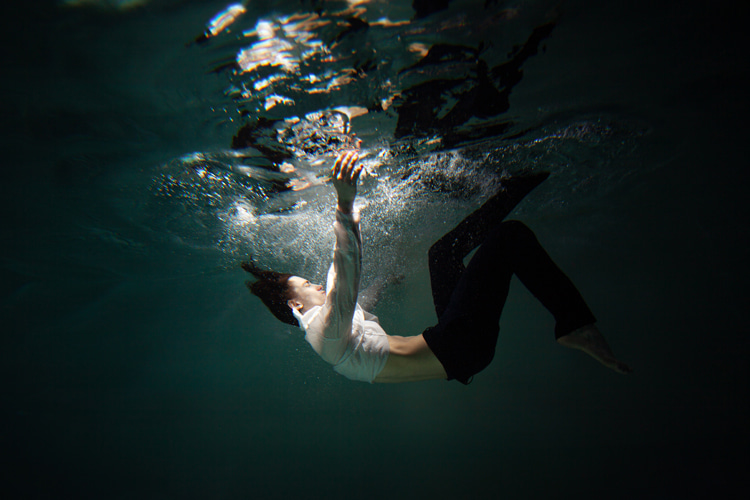What to do when you fall into water with your clothes on

Throughout our lives, we’re exposed to many situations involving large bodies of water. They can be as vast as the ocean or as small as a home pool, well, or tank.
Therefore, knowing how to swim is one of the first things a human should learn and master.
It’s a survival skill that can save our lives or take us out of tricky and uncomfortable situations.
So, the sooner children learn the basics of swimming, the better they will be prepared to deal with unexpected events and enjoy their time on the beach, in the surf, or in the pool.
If, for any reason, a person finds themself in a dangerous or life-threatening situation, they can dramatically increase survival time using two fundamental swimming techniques.
They are treading water and floating on your back in a star shape.
Mastering these two self-lifesaving methods could make the difference between life and death.
There’s even a third advanced water survival technique/instinct called mammalian diving reflex that anyone can take advantage of through training and practice.
Staying Afloat for Hours
Usually, the only enemy is water temperature and, consequently, hypothermia.
Nevertheless, the following chart tells us that a person can withstand 15 minutes to an indefinite period of time in the water:
- 70–80 °F (21–27 °C): 3 hours – indefinitely
- 60–70 °F (16–21 °C): 2-40 hours
- 50–60 °F (10–16 °C): 1-6 hours
- 40–50 °F (4–10 °C): 1-3 hours
- 32.5–40 °F (0–4° C): 30-90 minutes
- <32 F (<0 °C): Under 15-45 minutes
So, if someone finds themselves in trouble in a body of water, being able to stay afloat is critical and increases the chances of getting help.
Let’s take the ocean as an example. Imagine a person is dragged into the sea by a strong backwash.
Considering the global average ocean temperature is 60.9 °F (16.1 °C), they could stay alive for up to six hours or even more if they can tread water and float on their back.
These hours could be enough for a successful search and rescue operation.
According to the United States Lifesaving Association (USLA), over 100 people die yearly from rip currents.
The World Health Organization (WHO) adds that drowning is the third leading cause of unintentional injury death worldwide.
It accounts for 9 percent of all injury-related deaths.
Translated into numbers, it means that over 300,000 people annually drown to death worldwide. Impressive, isn’t it?

Drowning With Clothes On
Many accidents and tragedies in water bodies occur when people are with their clothes on.
They involve people of all ages and genders, including:
- Young children and elderly walking close to heavy shore breaks;
- Curious and playful adults challenging the breaking waves;
- Toddlers playing or walking by swimming pools;
- Fisherpeople working in boats;
- Random people living by ponds, ditches, and irrigation channels;
- Tourists unfamiliar with local open water surfaces;
- Migrants trying to flee their countries;
- Communities suddenly affected by severe floods;
- People under the influence of drugs or alcohol;
- Sailors involved in maritime accidents;
According to WHO’s report “Global Report on Drowning: Preventing a Leading Killer,” drowning accounts for 75 percent of deaths in flood disasters.
This fact is particularly shocking considering the number of regular flooding events taking place yearly across the globe.
Turning Pants Into Life Jackets
And if people are mostly taken by surprise and fall into the water with their clothes on, what could be done to increase their chances of survival?
Is there a way to make them a lifeline instead of a liability? Yes, there is.
Here’s what to do after falling into the water with your clothes on. It’s a technique used by military and navy personnel:
- Take your shoes off;
- Take your trousers off as soon as possible. If needed, take one or two deep breaths and watch what you’re doing underwater;
- Tie the pants’ legs together using two simple overhand knots;
- Zip up the zipper and button the button;
- Now it’s time to inflate the trousers. Grab the waistband behind your head and then throw it toward the front in one motion;
- The alternative inflation method also works. Hold the trousers waist wide open and splash air into both legs;
- There’s a third technique that uses your breath hold to inflate the pants underwater;
- Grab the pants by the waistband and place the improvised O-shaped life jacket around your neck;
- Stay afloat;
- If needed, blow and refill the pants with new air while waiting for rescue;
In most cases, regular clothes don’t add anything if we’re in survival mode. They’re just wet weights that do not protect us from cold water temperatures.
However, some swimming instructors teach children to swim with their clothes on if they accidentally fall into the water.
The lessons share valuable information on what to do and how to save themselves.
Words by Luís MP | Founder of SurferToday.com



